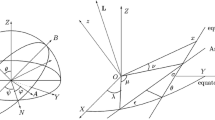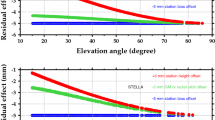Abstract
The Earth is under continuous influence of external attractive forces of the Sun and Moon, as well as an internal coupling between the Earth’s core and mantle and mass movements. This is why its rotation is not uniform. The direction of its rotation vector experiences long-term and periodic changes w.r.t. a space-fixed reference system (precession and nutation), as well as changes w.r.t. the Earth-fixed reference system (polar motion). Fluctuations in the Earth’s rotation speed are known as length of day (LOD) variations. Precession, nutation, polar motion, and length of day are together called Earth orientation parameters (EOP). They are the link between the celestial and terrestrial reference frames, and therefore, crucial in the transformation between them. This paper introduces the reader to the variable Earth rotation and the driving forces acting behind it, as well as the corresponding EOPs and reference frames. It gives a brief historical overview on latitudinal observations, and how they impacted the establishment of the today-known IERS (International Earth Rotation and Reference Systems Service). Furthermore, a description on the currently used techniques for the determination of EOPs is given at the end of this work, continuing with an example of utilizing GNSS observations for the determination of Earth rotation parameters (ERP).
Access this chapter
Tax calculation will be finalised at checkout
Purchases are for personal use only
Similar content being viewed by others
References
Fowler, C.M.R.: The Solid Earth: An introduction to Global Geophysics, 2nd edn. Cambridge University Press, Cambridge (2005)
Arora, K.: Geodesy, figure of the earth. In: Gupta, H.K. (eds.) Encyclopedia of Solid Earth Geophysics. Encyclopedia of Earth Sciences Series, pp. 313–316. Springer, Cham (2011). https://doi.org/10.1007/978-3-030-10475-7_83-1
Schindelegger, M.: Atmosphere-induced short period variations of earth rotation. Geowissenschaftliche Mitteilungen, Schriftreihe der Studienrichtung Vermessung und Geoinformation, Heft Nr. 96. Technische Universität Wien, Vienna (2014)
Sidorenkov, N.S.: The Interaction Between Earth’s Rotation and Geophysical Processes. Wiley-VCH Verlag GmbH & Co. KGaA, Weinheim (2009)
Böhm, S.: Tidal excitation of earth rotation observed by VLBI and GNSS. Geowissenschaftliche Mitteilungen, Schriftreihe der Studienrichtung Vermessung und Geoinformation, Heft Nr. 90. Technische Universität Wien, Vienna (2012)
Altamimi, Z., Collilieux, X., Métivier, L.: ITRF2008: an improved solution of the international terrestrial reference frame. J. Geodesy 85, 457–473 (2011)
Charlot, P., et al.: The third realization of the International Celestial Reference Frame by very long baseline interferometry. Astron. Astrophys. 644(A159), 1–28 (2020)
IERS ICRS Center Homepage: https://hpiers.obspm.fr/icrs-pc/newwww/icrf/index.php. Accessed 15 Jan 2022
Arias, E., Charlot, P., Feissel, M., Lestrade, J.F.: The extragalactic reference system of the International Earth Rotation Service, ICRS. Astron. Astrophys. 303, 604–608 (1995)
Petit, G., Luzum, B.: IERS Conventions 2010, IERS Technical Note No. 36, Verlag des Bundesamtes für Kartographie und Geodäsie, Frankfurt am Main (2010)
ITRF Website: Science background - General concepts. https://itrf.ensg.ign.fr/general.php. Accessed 15 Jan 2022
Altamimi, Z., Rebischung, P., Métivier, L., Collilieux, X.: ITRF2014: a new release of the international terrestrial reference Frame modelling nonlinear station motions. J. Geophys. Res. Solid Earth 121, 6109–6131 (2016)
Mulić, M.: Geodetski Referentni Sistemi. Građevinski fakultet Univerziteta u Sarajevu, Sarajevo (2018)
Latest International Terrestrial Reference Framework ITRF 2020 Becomes Operational. https://www.ncc.gov.ir/en/news/4889/latest-international-terrestrial-reference-framework-itrf-2020-becomes-operational. Accessed 15 Feb 2022
Schuh, H., Böhm, S.: Earth rotation. In: Gupta, H.K. (eds.) Encyclopedia of Solid Earth Geophysics. Encyclopedia of Earth Sciences Series, pp. 149–155. Springer, Cham (2021)
Böhm, S.: Erdrotation – Kapitel 1: Einführung, lecture slides, Erdrotation und globale dynamische Prozesse VO 128.010, Department für Geodäsie und Geoinformation, Technische Universität Wien, Vienna (2021)
Halilovic, D., Weber, R.: Contribution of Galileo observations to improve the quality of daily and sub-daily earth rotation parameter estimates. EGU General Assembly 2020, Online, 4–8 May 2020, EGU2020-3625 (2020)
Modiri, S., Belda, S., Hoseini, M., Heinkelmann, R., Ferrándiz, J.M., Schuh, H.: A new hybrid method to improve the ultra-short-term prediction of LOD. J. Geodesy 94(2), 1–14 (2020). https://doi.org/10.1007/s00190-020-01354-y
Seitz, F., Schuh, H.: Earth rotation. In: Xu, G. (ed.) Sciences of Geodesy – I, pp. 185–227. Springer, Heidelberg (2010)
Rothacher, M., Beutler, G., Herring, T.A., Weber, R.: Estimation of nutation using the global positioning system. J. Geophys. Res. Solid Earth 104, 4835–4859 (1999)
IERS – Int. Earth Rotation and Reference Systems Service Homepage: https://ggos.org/item/iers/#:~:text=The%20IERS%20was%20established%20as,operation%20on%201%20January%201988. Accessed 15 Feb 2022
IERS annual report 2017: https://www.iers.org/SharedDocs/Publikationen/EN/IERS/Publications/ar/ar2017/ar2017.pdf?__blob=publicationFile&v=4. Accessed 02 Apr 2022
Zajdel, R.: Determination of global geodetic parameters using the gps, glonass, and galileo satellite systems. Doctoral dissertation, Wrocław University of Environmental and Life Sciences, Wrocław (2021)
Sośnica, K., et al.: Satellite laser ranging to GPS and GLONASS. J. Geodesy 89(7), 725–743 (2015). https://doi.org/10.1007/s00190-015-0810-8
Dach, R., Lutz, S., Walser, P., Fridez, P. (eds.): Bernese GNSS Software Version 5.2. User manual, Astronomical Institute, University of Bern, Bern Open Publishing (2015)
Author information
Authors and Affiliations
Corresponding author
Editor information
Editors and Affiliations
Rights and permissions
Copyright information
© 2023 The Author(s), under exclusive license to Springer Nature Switzerland AG
About this paper
Cite this paper
Halilovic, D., Mulić, M., Weber, R. (2023). Earth Rotation and Its Parameters. In: Ademović, N., Mujčić, E., Mulić, M., Kevrić, J., Akšamija, Z. (eds) Advanced Technologies, Systems, and Applications VII. IAT 2022. Lecture Notes in Networks and Systems, vol 539. Springer, Cham. https://doi.org/10.1007/978-3-031-17697-5_38
Download citation
DOI: https://doi.org/10.1007/978-3-031-17697-5_38
Published:
Publisher Name: Springer, Cham
Print ISBN: 978-3-031-17696-8
Online ISBN: 978-3-031-17697-5
eBook Packages: Intelligent Technologies and RoboticsIntelligent Technologies and Robotics (R0)




